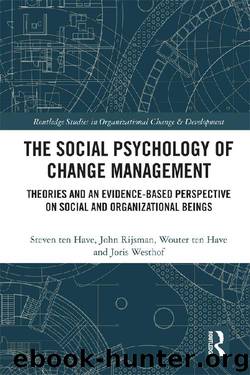The Social Psychology of Change Management by Joris Westhof & Wouter ten Have & John Rijsman & Steven ten Have

Author:Joris Westhof & Wouter ten Have & John Rijsman & Steven ten Have [Joris Westhof]
Language: eng
Format: epub
Publisher: Routledge
Published: 2018-12-16T22:00:00+00:00
What Is the Relevance of Motivation Crowding for Organization and Change?
The motivation crowding theory is relevant and helpful with regard to the context of organization and change, in particular behavioural change. It can be related to change-related topics such as leadership, culture and cultural change, change capacity, commitment, cooperation and compliance, and, last but not least, performance management. Focusing on cultural change, change capacity and performance management, one of the central questions is which behaviour has to be or can be stimulated or reinforced in what way. An answer calls for choices with regard to the stimuli, interventions, ‘reward and appraisal’. The concept of motivation crowding helps to understand what kind of interventions and rewards facilitate or possibly frustrate change and performance, as well as a factor such as job satisfaction. With regard to cooperation, commitment and compliance, Frey and Jegen (1999) provide research and insights into government rules and civic virtues (e.g. Schultz & Weingast, 1994). From the perspective of organizational citizenship behaviour (OCB, see: 5.5) and change, one could see an analogy that can be helpful in the context of organization and change. Frey and Jegen (1999) point to a body of research indicating that “people’s perceptions of how they are treated by the authorities strongly affect their evaluation of authorities and laws, and their willingness to cooperate with them… . Citizens who consider the constitution and its laws, and the authorities acting on the basis of them, to be fair and treating them respectfully tend to be more compliant than those with more negative perceptions of government” (p. 18).
These insights relate (at least in an analogical way) to essential topics in the area of change and organization such as trust (or confidence) in leaders, participation and fair process. Kriegel (1996), for example, emphasizes that resistance to change increases as trust in an organization’s leader decreases. Trustworthiness and believability are seen as the foundations of leadership. Watkins (2013) emphasizes the importance of credibility and trust in demanding situations: “As people come to trust your judgment, your ability to learn accelerates, and you equip yourself to make sound calls on tougher issues” (p. 8). Kouzes and Posner (2012) state that exemplary leaders create a climate of trust. Without trust you cannot accomplish extraordinary things. They state: “Trust is a strong, significant predictor of employee satisfaction, the quality of communication, honest sharing of information, acceptance of change, acceptance of the leader’s influence, and team and organizational performance” (pp. 219–220). Maurer (2010) states: “Trust can make or break a change. But sadly, many who lead change seem to ignore this critically important ingredient. They seem to believe that a good idea will win the day. It won’t” (p. 14). With regard to participation, an important element of the way people are treated (whether it is by ‘government’, leaders or change agents), Watkins (2013) points to the use of consultation to gain commitment: “Be clear on which elements of your vision are non-negotiable, but beyond these, be flexible enough to consider the ideas of others and allow them to have input and to influence the shared vision.
Download
This site does not store any files on its server. We only index and link to content provided by other sites. Please contact the content providers to delete copyright contents if any and email us, we'll remove relevant links or contents immediately.
The Brazilian Economy since the Great Financial Crisis of 20072008 by Philip Arestis Carolina Troncoso Baltar & Daniela Magalhães Prates(105953)
International Integration of the Brazilian Economy by Elias C. Grivoyannis(75747)
The Art of Coaching by Elena Aguilar(52214)
Flexible Working by Dale Gemma;(23213)
How to Stop Living Paycheck to Paycheck by Avery Breyer(19572)
The Acquirer's Multiple: How the Billionaire Contrarians of Deep Value Beat the Market by Tobias Carlisle(12115)
Thinking, Fast and Slow by Kahneman Daniel(11808)
The Radium Girls by Kate Moore(11639)
The Art of Thinking Clearly by Rolf Dobelli(9930)
Hit Refresh by Satya Nadella(8870)
The Compound Effect by Darren Hardy(8527)
Atomic Habits: Tiny Changes, Remarkable Results by James Clear(8055)
Tools of Titans by Timothy Ferriss(7830)
Turbulence by E. J. Noyes(7717)
Change Your Questions, Change Your Life by Marilee Adams(7388)
A Court of Wings and Ruin by Sarah J. Maas(7286)
Nudge - Improving Decisions about Health, Wealth, and Happiness by Thaler Sunstein(7261)
How to Be a Bawse: A Guide to Conquering Life by Lilly Singh(7167)
Win Bigly by Scott Adams(6836)
